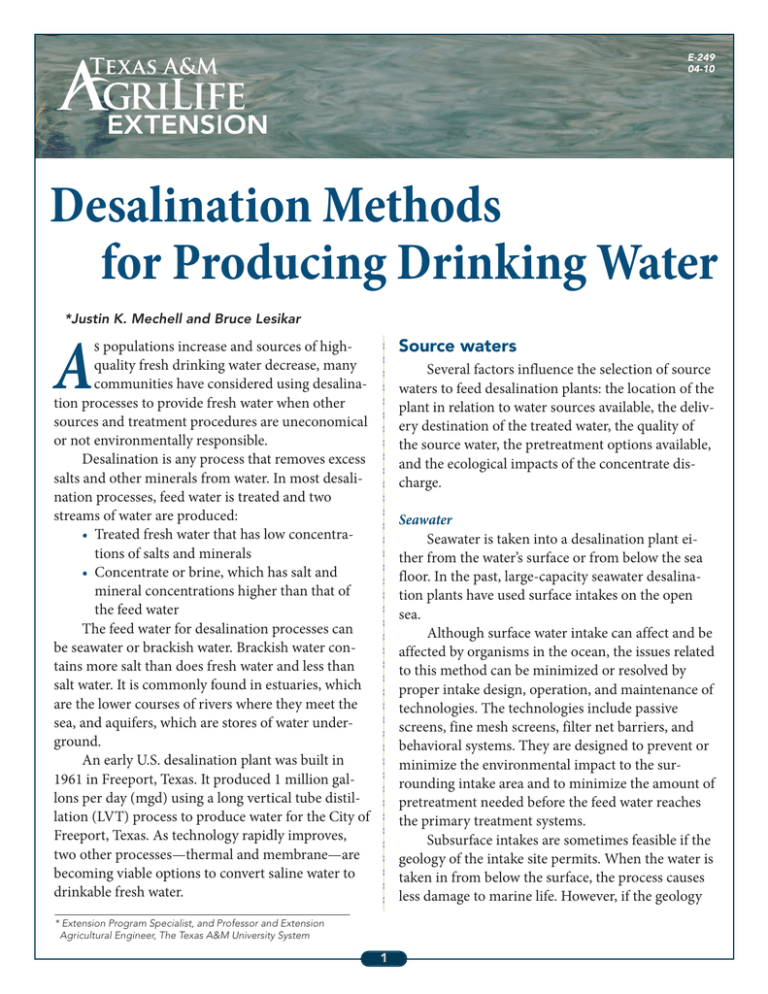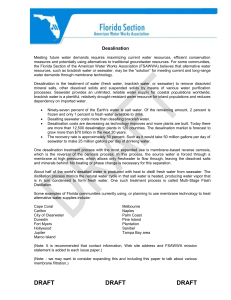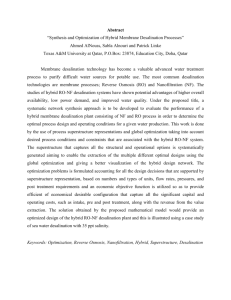A Desalination Methods for Producing Drinking Water Source waters
advertisement

E-249 04-10 Desalination Methods for Producing Drinking Water *Justin K. Mechell and Bruce Lesikar Source waters s populations increase and sources of high- A quality fresh drinking water decrease, many communities have considered using desalination processes to provide fresh water when other sources and treatment procedures are uneconomical or not environmentally responsible. Desalination is any process that removes excess salts and other minerals from water. In most desalination processes, feed water is treated and two streams of water are produced: • Treated fresh water that has low concentrations of salts and minerals • Concentrate or brine, which has salt and mineral concentrations higher than that of the feed water The feed water for desalination processes can be seawater or brackish water. Brackish water contains more salt than does fresh water and less than salt water. It is commonly found in estuaries, which are the lower courses of rivers where they meet the sea, and aquifers, which are stores of water underground. An early U.S. desalination plant was built in 1961 in Freeport, Texas. It produced 1 million gallons per day (mgd) using a long vertical tube distillation (LVT) process to produce water for the City of Freeport, Texas. As technology rapidly improves, two other processes—thermal and membrane—are becoming viable options to convert saline water to drinkable fresh water. Several factors influence the selection of source waters to feed desalination plants: the location of the plant in relation to water sources available, the delivery destination of the treated water, the quality of the source water, the pretreatment options available, and the ecological impacts of the concentrate discharge. Seawater Seawater is taken into a desalination plant either from the water’s surface or from below the sea floor. In the past, large-capacity seawater desalination plants have used surface intakes on the open sea. Although surface water intake can affect and be affected by organisms in the ocean, the issues related to this method can be minimized or resolved by proper intake design, operation, and maintenance of technologies. The technologies include passive screens, fine mesh screens, filter net barriers, and behavioral systems. They are designed to prevent or minimize the environmental impact to the surrounding intake area and to minimize the amount of pretreatment needed before the feed water reaches the primary treatment systems. Subsurface intakes are sometimes feasible if the geology of the intake site permits. When the water is taken in from below the surface, the process causes less damage to marine life. However, if the geology * Extension Program Specialist, and Professor and Extension Agricultural Engineer, The Texas A&M University System 1 Figure 1. Example of a multi-stage flash distillation (MSF) process (Source: Buros, 1990). tion (MED), and vapor compression distillation (VCD). Another thermal method, solar distillation, is typically used for very small production rates. Membrane distillation technologies are primarily used in the United States. These systems treat the feed water by using a pressure gradient to forcefeed the water through membranes. The three major membrane processes are electrodialysis (ED), electrodialysis reversal (EDR), and reverse osmosis (RO). of the site is unfavorable, a subsurface intake can harm nearby freshwater aquifers. Methods of subsurface intake include vertical beach wells, radial wells, and infiltration galleries. A major advantage to using a subsurface intake is that the water is filtered naturally as it passes through the soil profile to the intake. This filtration improves the quality of feed water, decreasing the need for pretreatment. Brackish water Brackish water is commonly used as a source for desalination facilities. It is usually pulled from local estuaries or brackish inland water wells. Because it typically has less salt and a lower concentration of suspended solids than does seawater, brackish water needs less pretreatment, which decreases overall production costs. However, a disadvantage is that disposing of the brine from an inland desalination location increases the cost and can raise environmental concerns. Thermal technologies Multi-stage flash distillation Multi-stage flash distillation is a process that sends the saline feed water through multiple chambers (Fig. 1). In these chambers, the water is heated and compressed to a high temperature and high pressure. As the water progressively passes through the chambers, the pressure is reduced, causing the water to rapidly boil. The vapor, which is fresh water, is produced in each chamber from boiling and then is condensed and collected. Desalination technologies Two distillation technologies are used primarily around the world for desalination: thermal distillation and membrane distillation. Thermal distillation technologies are widely used in the Middle East, primarily because the region’s petroleum reserves keep energy costs low. The three major, large-scale thermal processes are multistage flash distillation (MSF), multi-effect distilla- Multi-effect distillation Multi-effect distillation employs the same principals as the multi-stage flash distillation process except that instead of using multiple chambers of a single vessel, MED uses successive vessels (Fig. 2). The water vapor that is formed when the water boils is condensed and collected. The multiple vessels make the MED process more efficient. 2 Figure 2. Example of a multi-effect distillation (MED) process (Source: Buros, 1990). solar distillation units vary greatly, the basic principals are the same. The sun provides the energy to evaporate the saline water. The water vapor formed from the evaporation process then condenses on the clear glass or plastic covering and is collected as fresh water in the condensate trough. The covering is used to both transmit radiant energy and allow water vapor to condense on its interior surface. The salt and un-evaporated water left behind in the still basin forms the brine solution that must be discarded appropriately. This practice is often used in arid regions where safe fresh water is not available. Solar distil- Vapor compression distillation Vapor compression distillation can function independently or be used in combination with another thermal distillation process. VCD uses heat from the compression of vapor to evaporate the feed water (Fig. 3). VCD units are commonly used to produce fresh water for small- to medium-scale purposes such as resorts, industries, and petroleum drilling sites. Solar distillation Solar desalination is generally used for smallscale operations (Fig. 4). Although the designs of Figure 3. Example of a vapor compression distillation (VCD) process (Source: Buros, 1990). 3 built to allow passage of either positively or negatively charged ions, but not both. Ions are atoms or molecules that have a net positive or net negative charge. Four common ionic molecules in saline water are sodium, chloride, calcium, and carbonate. Electrodialysis and electrodialysis reversal use the driving force of an electrical potential to attract Figure 4. Example of a solar still desalination process (Source: Buros, 1990). and move different cations (positively charged ions) or lation units produce differing amounts of fresh anions (negatively charged ions) through a permewater, according to their design and geographic loable membrane, producing fresh water on the other cation. Recent tests on four solar still designs by the side (Fig. 5). Texas AgriLife Extension Service in College Station, The cations are attracted to the negative elecTexas, have shown that a solar still with as little as trode, and the anions are attracted to the positive 7.5 square feet of surface area can produce enough electrode. When the membranes are placed so that water for a person to survive. Membrane technologies A membrane desalination process uses a physical barrier—the membrane—and a driving force. The driving force can be an electrical potential, which is used in electrodialysis or electrodialysis reversal, or a pressure gradient, which is used in reverse osmosis. Membrane technologies often require that the water undergo chemical and physical pretreatment to limit blockage by debris and scale formation on the membrane surfaces. Table 1 (page 5) details the basic characteristics of membrane processes. Electrodialysis and electrodialysis reversal The membranes used in electrodialysis and electrodialysis reversal are Figure 5. Example of an electrodialysis process showing the basic movements of ions in the treatment process (Source: Buros, 1990). 4 Table 1. General characteristics of membrane processes (Source: Metcalf and Eddy, 2003). Membrane process Membrane driving force Typical separation mechanism Operating structure (pore size) Typical operating range, (µm) Permeate description Typical constituents removed Microfiltration Hydrostatic pressure difference or vacuum in open vessels Sieve Macropores (> 50 nm) 0.08–2.0 Water + dissolved solutes TSS, turbidity, protozoan oocysts and cysts, some bacteria and viruses Ultrafiltration Hydrostatic pressure difference Sieve Mesopores (2–50 nm) 0.005–0.2 Water + small molecules Macromolecules, colloids, most bacteria, some viruses, proteins Nanofiltration Hydrostatic pressure difference Sieve + solution/ diffusion + exclusion Micropores (< 2 nm) 0.001–0.01 Water + very small molecules, ionic solutes Small molecules, some hardness, viruses Reverse osmosis Hydrostatic pressure difference Solution/ diffusion + exclusion Dense (< 2 nm) 0.0001– 0.001 Water + very small molecules, ionic solutes Very small molecules, color, hardness, sulfates, nitrate, sodium, other ions Dialysis Concentration difference Diffusion Mesopores (2–50 nm) -- Water + small molecules Macromolecules, colloids, most bacteria, some viruses, proteins Electrodialysis Electromotive force Ion exchange with selective membranes Micropores (< 2 nm) -- Water + ionic solutes Ionized salt ions Reverse osmosis some allow only cations to pass and others allow only anions to pass, the process can effectively remove the constituents from the feed water that make it a saline solution. The electrodialysis reversal process functions as does the electrodialysis process; the only difference is that in the reverse process, the polarity, or charge, of the electrodes is switched periodically. This reversal in flow of ions helps remove scaling and other debris from the membranes, which extends the system’s operating life. Reverse osmosis uses a pressure gradient as the driving force to move high-pressure saline feed water through a membrane that prevents the salt ions from passing (Fig. 6). There are several membrane treatment processes, including reverse osmosis, nanofiltration, ultrafiltration, and microfiltration. The pore sizes of the membranes differ according to the type of process (Fig. 7). 5 Because the RO membrane has such small pores, the feed water must be pretreated adequately before being passed through it. The water can be pretreated chemically, to prevent biological growth and scaling, and physically, to remove any susFigure 6. Basic components of a membrane treatment process. pended solids. The high-pressure feed water flows through the individual membrane elements. The spiral RO membrane element is constructed in a concentric spiral pattern that allows alternating layers of feed water and brine spacing, RO membrane, and a porous product water carrier (Fig. 8). The porous product water carrier allows the fresh water to flow into the center of the membrane element to be collected in the product water tube. To enable each Figure 7. Range of nominal membrane pore sizes for reverse osmosis (RO), pressure vessel to treat nanofiltration (NF), ultrafiltration (UF), and microfiltration (MF) (Source: Metcalf more water, the individ- and Eddy, 2003). ual membrane elements are connected in series (Fig. 9). After the water chemicals that were either removed during the depasses through the membrane elements within the salination process or added to help pretreat the feed pressure vessels, it goes through post treatment. Post water. For all of the processes, the brine must be distreatment prepares the water for distribution to the posed of in an economical and environmentally public. friendly way. Options for discharging the brine include discharge into the ocean, injection through a well into a Concentrate management options saline aquifer, and evaporation. Each option has adBoth thermal and membrane desalination vantages and disadvantages. In all cases, the brine processes produce a stream of brine water that has a water should have a minimal impact on the surhigh concentration of salt and other minerals or 6 Figure 8. Cutaway view of a spiral reverse osmosis membrane element (Source: Buros, 1990). implementation, desalination processes need technological improvements and increased energy efficiency. rounding water bodies or aquifers. Specific considerations for the water quality include saline concentration, water temperature, dissolved oxygen concentrations, and any constituents added as pretreatment. References Buros, O. K., The ABC’s of Desalting, International Desalination Association. Topsfield, Massachusetts. 1990. Krishna, Hari J., Introduction to Desalination Technologies, Texas Water Development Board. 2004. Metcalf and Eddy, Wastewater Engineering: Treatment and Reuse. McGraw-Hill, Inc., New York. 2003. Pankratz, Tom, Desalination Technology Trends, CH2M Hill, Inc. 2004. Summary As high-quality freshwater resources decrease, more communities will consider desalination of brackish and salt water to produce drinking water. All desalination technologies have advantages and disadvantages based on site-specific limitations and requirements. Small-scale desalination of brackish water using solar stills is a promising method in remote locations where good-quality water for drinking and cooking is unavailable. For more widespread Figure 9. Cross section of a pressure vessel with three membrane elements (Source: Buros, 1990). 7 This material is based on work supported by the National Institute of Food and Agriculture, U.S. Department of Agriculture, under Agreement No. 2009-34461-19772 and Agreement No. 2009-45049-05492.






